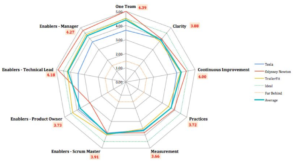To measure is to know. If you can not measure it, you can not improve it. – Lord Kelvin Like any other assessment, agility maturity assessment also happens at every state of agile implementation & that too frequently. We have used Agile Maturity Assessment in measuring the state of agile implementation at many levels – individual, team, group of teams in a program/portfolio and also at an organization level. And it is tweaked based on relevance. The most common implementation happens at team level. And this is how we do it for a team which is using scrum approach –
- Imagine, you are coaching a team for quite some time and now you want to know how healthy they are. Usually, we recommend quarterly rhythm to conduct such assessments.
- What do you need to have in place to conduct Agile maturity assessment? At a high level, below are the steps :
- An Agility Health Survey
- Blocking stakeholder calendar & Sharing expectations
- Collecting insights via a survey tool
- Collating insights
- Present findings and creating a growth plan with recommendations
Let’s discuss these steps in more detail. Agile Maturity survey – this first step is to design an Agile Maturity survey which is relevant to your teams and project environment. Below is a basic step wise process which has worked for us.
- Identify the focus areas that you want to assess like – Clarity of roles & events, Leadership support, continuous improvement, culture, adaptability – anything that in your environment you want to improve by implementing agile ways of working
- Survey statements against each focus area – Think of 10-15 easy to understand yet insightful statements against each focus area. Statements should capture the essence of the focus area, check below examples for ‘Culture’ as a focus area.
- We think as ONE team and not silos
- We understand that change even in later part of development is acceptable
- In our team, everybody pulls their work since we do not assign the work
- Ensure that you include open ended subjective questions for each focus area
- Identify the scale of response that participants will give, for example :
- Rating – 1 to 5 where 1 is Not happening & 5 is exceeding expectations
- Moods – Sad, Mad, Glad
- Visual imagination – Pre-crawl, Crawl, Walk, Run, Fly
- Anything that makes sense to you & it will be easier for participants.
- Populate the survey tool. Conducting the assessment online is easier these days and there are tools which can help you with metric views on the data you have collected which will simplify the analysis.
- Ensure that the survey pages are organized neatly. We prefer one page for one focus area & the statements it contains.
- Few tools we have used – Google forms, SurveyGizmo, SurveyMonkey, LimeSurvey
Blocking stakeholder calendar & Sharing expectations – It’s important to set the context and purpose of the assessment with all the stakeholders to get their buy-in and ensure the effectiveness of the entire process. You will need to do the following :
- Book the appointments – Book two appointments with your target team:
-
- First appointment, of 3 hours/team where you as a facilitator of assessment will conduct the assessment and collect the inputs from all the participants
- Second appointment, of 2 hours where you will present the findings of the assessment post-analysis and help the team in preparing the growth plan.
- Whom should you invite?
-
- Entire scrum team – Product Owner, Development Team/Developers, Scrum Master
- Team’s reporting manager/s (selective participation)
- Client stakeholders/sponsors (selective participation)
- Representatives of supporting team (selective participation)
- // Selective participation implies, these participants will be having a separate survey to fill which is focused to their role
- Reconfirm participation. Ensure that all the participants MUST show up.
Collect the Insights via a Survey Tool
- Explain the focus areas & create comfort
- Ensure the participants understand the importance of the survey and their responses will be anonymous
- Share the links with Scrum Team members
- Share the separate focused links with other participant groups – client stakeholders, sponsors, reporting managers, supporting team members & others. Since they may get done sooner hence they may leave.
- Kickstart the assessment
-
- Keep a timebox for each ‘Focus Area’ page. Nearly 5-15 min could be needed by participants to respond.
- Clarify doubts on statements – right understanding is paramount
- Continuity is key.. Incase taking breaks then pls don’t keep it more than 2 min otherwise it is tough to get the hold of participants
- Conclude,
-
- Ensure all participants have submitted and tally the count of submissions with your survey dashboard
- Remind all to participate in the next appointment to look at the survey report and prepare growth plan
Collating Insights
- Almost all tools provide facility to download the responses in your preferred format
- We prefer to collate following information:
-
- Strong points – choose top 5-8
- Weak points – choose top 5-8
- Top Agreements & Disagreements – choose top 5-8
- Collate Subjective answers
- Use Radar chart to show the average scores against each focus area
- Ensure to reword or remove any profanity used 🙂
Present findings and create a growth plan with recommendations
- All who have participated in responding to assessments are expected to participate in this event also in its entirety
- First part, present
- Present the findings that you have prepared
- The conversations will be triggered, let it flow
- Let it all sink in
- Request people to make notes of their key observations for the later part
- Second part, growth plan creation
-
- Collect. Probe people about the key improvements that they want to bring it and use some tool to collect all such pointers
- Discuss. Show them the improvements that they have shared and try to merge those which are similar. Let’s say we have consolidated them in a list called “GROWTH”
- Vote. Ask them all to vote 2 (or any count) against the items in the GROWTH list
- Now, identify the top voted items

Agile Maturity Assessment is OVER but now the real action is to help the team in achieving the GROWTH PLAN 🙂 It may sound like any other assessment but it has its own distincts –
- It’s not an audit but a self-assessment
- Anonymity of respondents is respected
- Your role is to just be a facilitator and the respondents are the main actors
- It’s progressive. Happens every quarter and you can compare the scores to analyse
Here’s how a sample Agile Maturity Assessment chart will look like :

Maximize effectiveness with agile training and consulting, merging practical skills with strategic guidance for lasting impact.

